Really want to see what your eyes can do? Leave the telescope at home and join me for a naked-eye tour of the late winter sky.
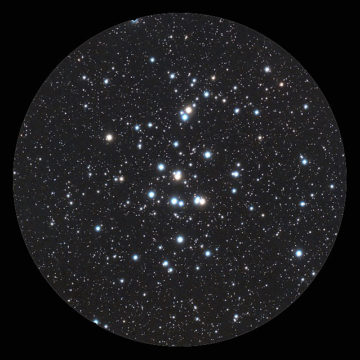
Chad Quandt
I continue to be amazed by how many deep-sky objects are visible with the naked eye. In a blog last June I wrote about finding 23 summertime clusters and nebulae. This winter I put my eyes to the test again.
If mosquitoes were an issue in July, this winter has been generous with gifts of cold and snow. Temperatures frigid enough to freeze my eyelids shut have been the norm, but a new pair of insulated bib overalls gave me the confidence to brave the night.
As before, I made my observations under rural Bortle Class 3 skies with a limiting magnitude of about 6.5, an easily visible Milky Way band, and only modest light pollution to the south. I expected to see maybe a dozen clusters and nebulae but was delighted to coax out many more.
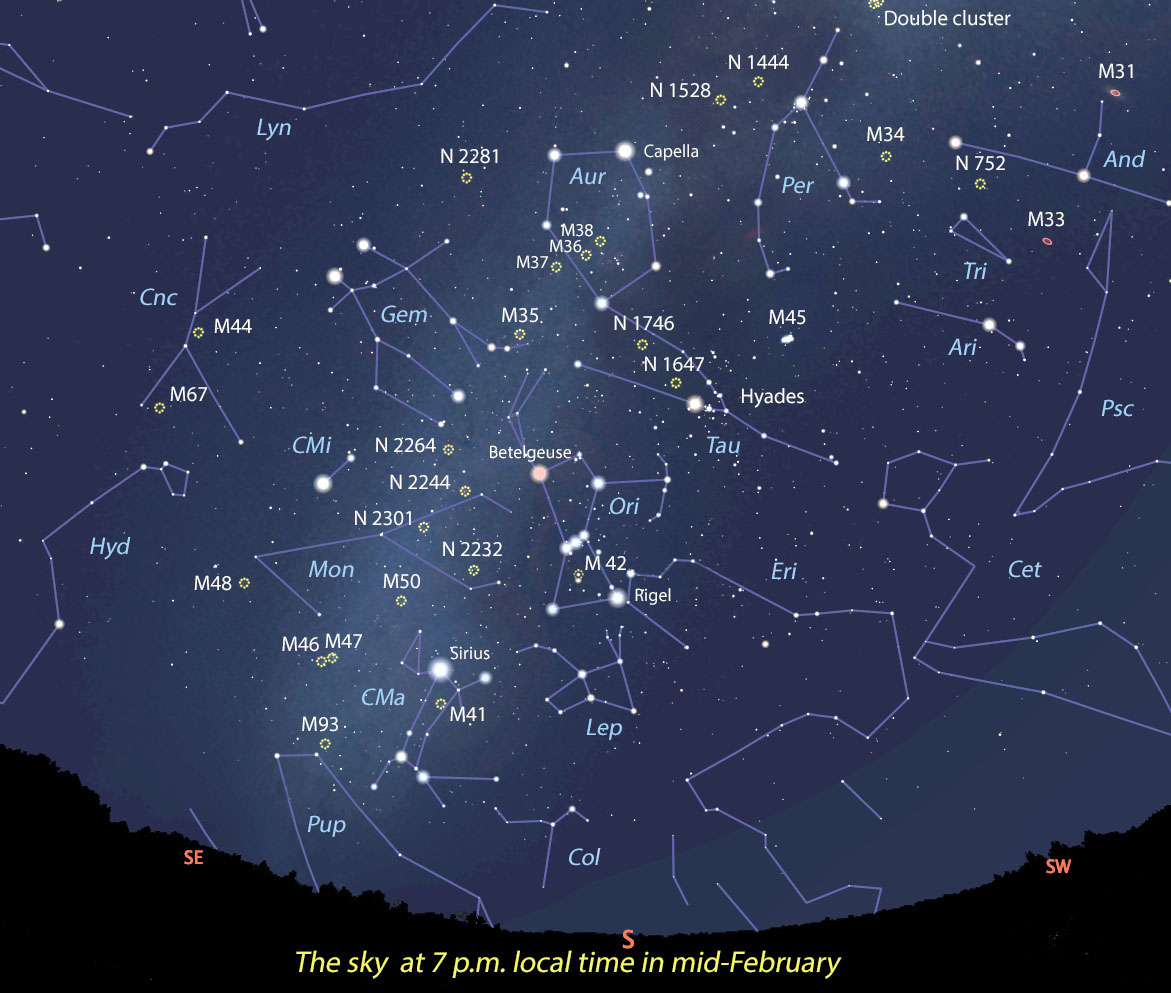
Stellarium with additions by the author
Outside of the Pleiades and Hyades, the majority of the 27 objects could hardly be called spectacular. Most were small, nebulous spots. That said, they varied in size and brightness, with some showing a shape and others flecked with faint stars that popped in and out of view like baby chicks straining to lift their heads from the nest. Understandably, some observers might find seeking faint, nearly featureless objects with the naked eye unexciting, but the simple fact of seeing so much with only biology was thrill enough. And amateurs know well that observing near the limit of vision enhances one's ability to concentrate and see more whether with a telescope or not.
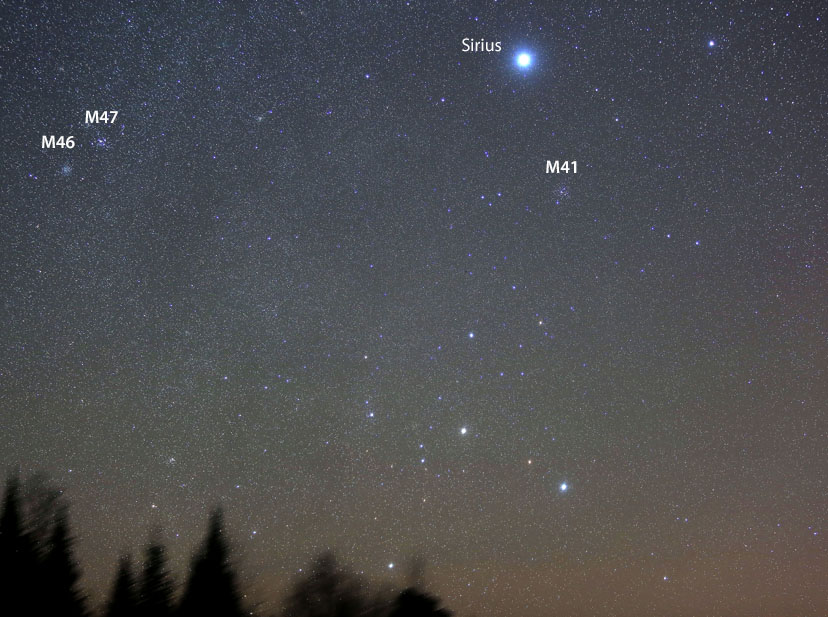
Bob King
Each time I looked up, I couldn't help but think of the ancient observers who scanned even darker skies before me. Their gaze passed over every single star cluster, galaxy and nebula mine did. Most deep-sky objects were missed by those early stargazers simply because they didn't know they were there. Maybe in a few cases they saw a puff of haze and dismissed it. Now we have maps ... and corrective lenses to sharpen our sight.
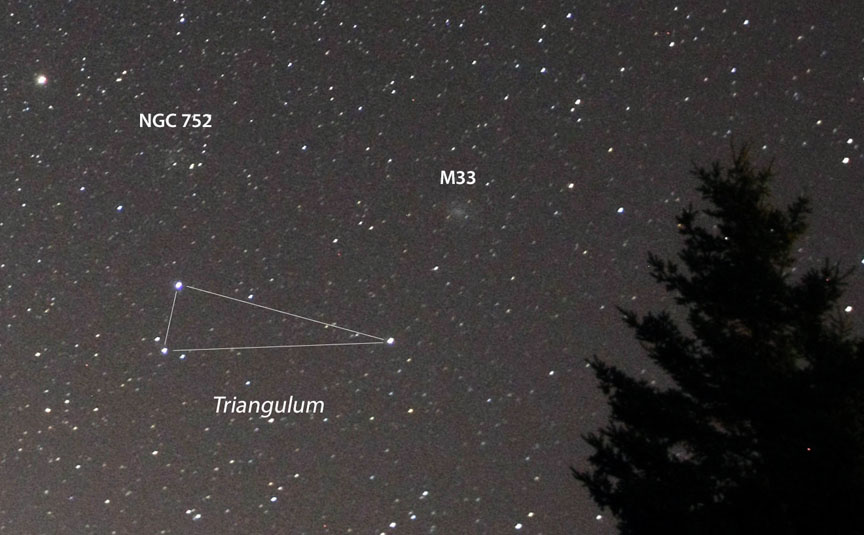
Bob King
Like last June, I assigned each object a "degree of difficulty" ranging from Level 1 (Easy Pickins) to Level 4 (Challenging). The Moon will be out of the evening sky as soon as tomorrow night (February 21st), so you can start to look for these tiny treasures at the first opportunity. I recommend starting at nightfall, so you can still catch good views of the Triangulum Galaxy and neighboring NGC 752 in the western sky. From there, work eastward to Cancer and Hydra, which become well-placed later in the evening.
Working your way with the naked eye across the sky feels a little like doing a Messier Marathon and makes good practice for that upcoming event. But here's one sweet difference — you don't have to stand at a telescope. I like to relax in an adjustable, folding lawn chair, charts at my side and binoculars in hand. Binoculars are useful to confirm your observation and also give great views of these brighter objects.
Level 1: Easy Pickins
Let's start at Pleiades (M45) and Hyades, two of the brightest star clusters in the sky. Face southwest at nightfall, look up, and bam — there they are, parked right next door to each other. Most people see five of the seven sisters, but it only takes a little effort to pick out more. Averted vision will spring at least two more members and up to 14 if you're viewing from a dark sky and possess excellent vision. For more on picking Pleiads, check out my earlier blog on the topic.
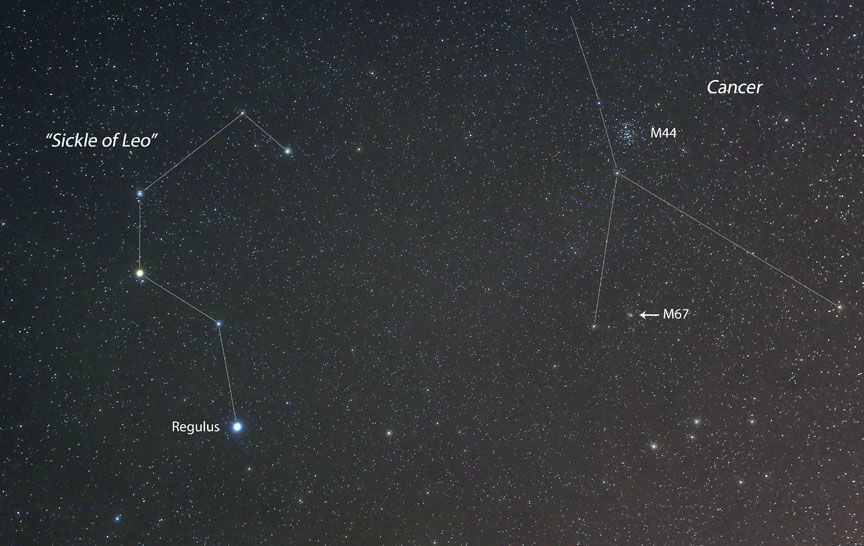
Bob King
The Hyades are closer and more spread out with about a dozen stars visible from a dark sky. Several are wide doubles and make attractive sights with the naked eye and binoculars. For more details on scoping out the Hyades, click here. If you don't fully appreciate these clusters at the start of your naked-eye deep-sky run, you will at the end. They're absolutely spectacular in comparison to the minimalist fare we'll visit after M44, the last of the easy ones.
At magnitude 3.7, the Beehive (M44) is one of the brighter clusters in the sky. Many of us still use it as an indicator of clear skies, one of its purposes of old. When high clouds are absent and light pollution minimal, the cluster is obvious, but if it takes effort to make it out, something's afoot. Incredibly, the light of a thousand suns goes into making this 1.5°-wide dab of luminous haze. Binoculars show it best, but close inspection with averted vision will reveal a faintly glimmering texture.
Level 2: Eyeball Exercisers
The next tier includes NGC 752 in Andromeda, the Orion Nebula (M42), NGC 2244 with the Rosette Nebula, M34, M35, M47, and M48. NGC 752 at magnitude 5.7 is one of the larger fall/winter star clusters with a diameter of 75′ (arcminutes). Unlike many of the groups I observed, this one had a good spread — I estimated about 1° across. The cluster appeared granulated, with tiny stellar twinkles on the verge of resolution. I also glimpsed several brighter stars along its western border which may or may not have been members. Not far to the northeast I was pleased to find M34 an easy target at magnitude 5.5 and 35′ across. It looked very compact, almost stellar at first glance but more extended on closer examination.
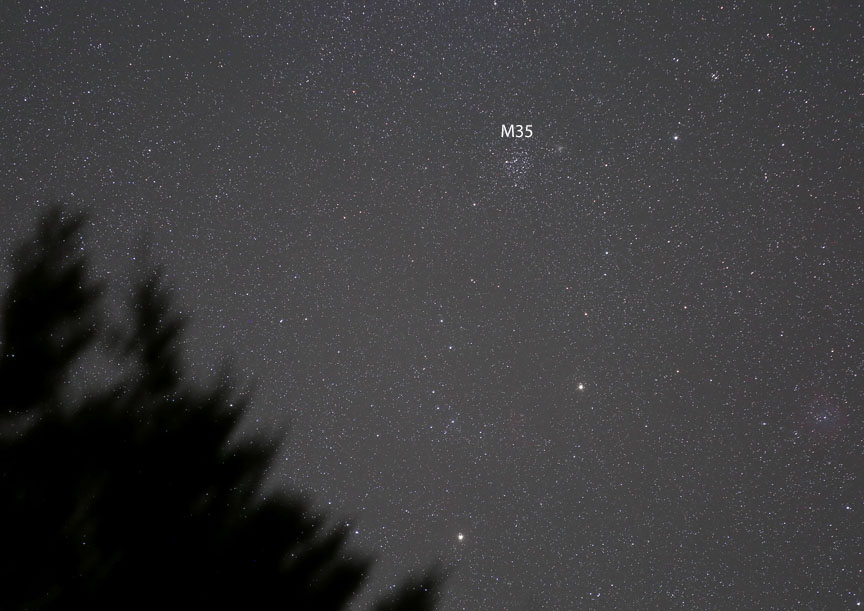
Bob King
At magnitude 4.0, the Orion Nebula is easy to spot even from the suburbs as a haze around the middle star in Orion's Sword. Although the nebulosity appears completely amorphous to the naked eye, I discovered with concentration I could tease out the Trapezium as a single, slightly fainter star close northwest of Theta2 (θ2) Orionis. The Rosette cluster (NGC 2244) and nebula proved a revelation. Both cluster and nebula blend into a small, dense patch of light obviously elongated northwest-southeast. Every so often, one or two cluster stars would flicker in and out view. I had no idea how easy this object was to see.
M35 (magnitude 5.1) is another easy deep-sky sight, appearing as a round, nebulous glow about the size of the full Moon dotted by evanescent flickers of starlight. M41 is one of my favorite naked-eye clusters. Given how obvious it is from the northern U.S., it must be unmissable to southern stargazers. Located 4° south-southwest of Sirius and shining at magnitude 4.5 and 38′ across, I saw an extended glow with a brighter, not-quite-stellar spot at its center. M47, 12° east of Sirius in Puppis, is even brighter at magnitude 4.2 and 30′ across. I instantly discerned its elongated east-west shape and spotted two of its brightest stars (magnitudes of 5.7 and 6.5).
Further east, some 3° southeast of Zeta (ζ) Monocerotis, we arrive at the open cluster M48, listed at magnitude 5.8 and 30′ across. What a pleasant surprise! It was an obvious little blob of fuzz half as big as the Moon with a granulated appearance, indicating stars on the verge of visibility.
Level 3: Hurts a Little
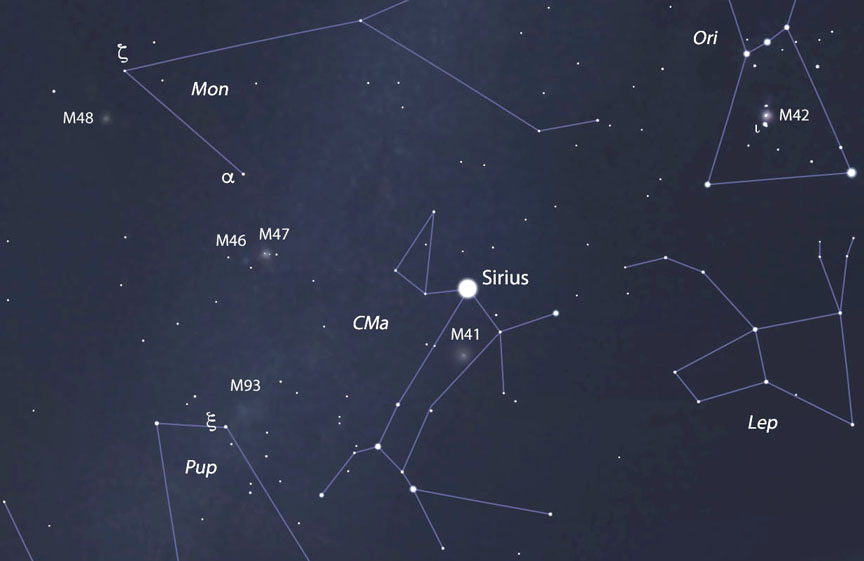
These more challenging deep-sky treats require a little extra patience and concentration, but they weren't what you'd call difficult even for my older-dude eyes. One thing that drops away are the occasional stars and granulation you'd otherwise see in some of the Level 2 objects. Nearly all of them also required averted vision:
- NGC 1444 (magnitude 6.6, 4′ diameter), open cluster in Perseus — Faint, extended patch.
- NGC 1528 (6.4, 23′), open cluster in Perseus — Several stars nearby both help and hinder in discerning this tiny, compact glow. Once you ignore the stars, this one pops out pretty well with averted vision.
- NGC 1746 (6.0, 40′), asterism in Taurus — A large, amorphous haze that appeared nearly 1° across with hints of granulation. I had no problem seeing what most atlases still label as a star cluster, but it appears that NGC 1746 may instead be an asterism according to a recent study. Get this, though: two fainter, overlapping clusters — NGC 1750 and 1758 — that lie behind the asterism are for reals.
- M37 (6.2, 24′), open cluster in Auriga — Easiest of the three Auriga Messier clusters but still little more than a faint, round puff with averted vision. Light from the Milky Way competes.
- NGC 2232 (3.9, 30′), open cluster in Monoceros — The cluster's brightest star, 5th-magnitude 10 Mon, was immediately obvious, topping a wisp of cluster haze to its south.
- NGC 2281 (5.4, 25′), open cluster in Auriga — Vague, uncondensed glow.
- NGC 2264 (3.9, 20′), the Christmas Tree Cluster in Monoceros — The bright magnitude would lead you to believe this an easy cluster. Its brightest member, 15 Mon, shines at magnitude 4.7, but digging out the cluster takes some work. I saw it only occasionally with averted vision as a faint "extension" south of the star.
- M50 (5.9, 16′), open cluster in Monoceros — Dim but visible as a small misty spot with averted vision.
Level 4: Challenging
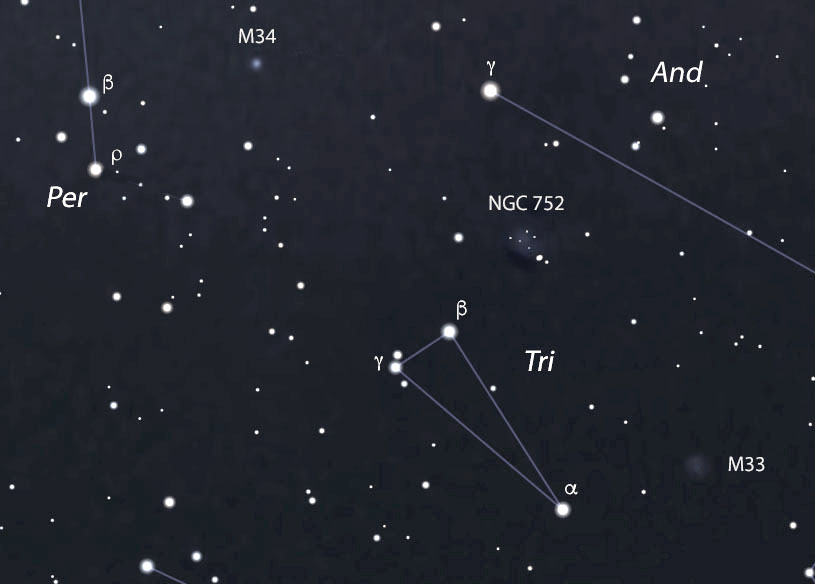
Stellarium with additions by the author
-
- M33 (5.7, 71′ × 42′), Triangulum Galaxy — A difficult object. Faint, extended, smooth glow.
- NGC 1647 (6.4, 45′), star cluster in Taurus 4° northeast of Aldebaran — At first I thought this one was relatively easy until I realized that several faint stars northeast of the true cluster were unrelated. Once they were ignored I finally confirmed the cluster as a faint, extended haze.
- M38 (7.4, 21′), open cluster in Auriga — As hard as they come. More difficult than M33. Glimpsed occasionally with averted vision after multiple attempts.
- M36 (6.3, 10′), open cluster in Auriga — Similar to M38 but an even smaller "spot" in the surrounding Milky Way.
- NGC 2301 (6.0, 12′), open cluster in Monoceros — Very faint, slightly elongated wisp.
- M46 (6.1, 23′), open cluster in Puppis — I shouldn't have been surprised at how difficult this one was given its altitude of just 33° from my observing site. Faint, averted-vision glow close southeast of its glittery neighbor, M47.
- M93 (6.2, 10′), open cluster in Puppis — Only suspected as the faintest of hazy blotches. Peak altitude of just 24°. Undoubtedly much easier from the Deep South!
- M67 (6.1, 30′), open cluster in Cancer — Cancer's "other" star cluster. A faint object that took a bit of work to confirm, but it was clearly seen with averted vision as a smudgy spot 1.7° west of Alpha (α) Cancri.
There you have it — equipment-less observing. Nothing to carry, set up, or take down except a chair. And I promise you'll walk away with a new respect for the power of your own eyeballs.
 10
10








Comments
Russell Sampson
February 20, 2019 at 12:31 pm
Excellent article. For many years I have been interested in the limits of our vision and perception and how those limits translate to what we can see in the sky. I have also wondered how much of our at-the-edge observing is actual seeing versus wishful thinking. With star charts and catalogs in our hands and in our minds we already know where to look, and what the object should look like. Thus our mind is primed - and hence biased - with foreknowledge and expectation. It would be interesting to do an experiment where such bias is removed, or even artificially inserted. Point a telescope to a random part of the sky and tell another observer that in the center of the field is a faint galaxy. Do they "see" it, because you said it was there? Now point the telescope to a real object that is at the limit of visibility. Without divulging its presence, simply ask the observer to describe what they see in the field. Do they see it?
You must be logged in to post a comment.
Bob KingPost Author
February 20, 2019 at 6:17 pm
Thank you, Russell. I tend to be skeptical just like you when it comes to visibility of objects near the limit of vision. If I can't repeatedly confirm an observation, I always consider it tentative. I'll bust an eyeball if I have to before conceding 🙂
You must be logged in to post a comment.
Rod
February 20, 2019 at 1:36 pm
Bob King, good list and report. Where I am at in Maryland, perhaps 5.5/5.6 limiting magnitude. I prefer to view targets at higher elevation angles vs. when they first rise, low in E sky. Objects closer to my zenith are better views and objects over to the W and NW are not good views. I can see with unaided eyes M35, M41, M31, M44 as well as your earlier report on some double stars in Hyades cluster.
You must be logged in to post a comment.
Bob KingPost Author
February 20, 2019 at 6:19 pm
Hi Rod,
I wish everything were at the zenith all the time. Next time I get a magic lamp I'll wish for it! Sounds like you have pretty good skies to be able to spot M35 (thankfully, a "higher up" object).
You must be logged in to post a comment.
SNH
February 20, 2019 at 3:49 pm
Well, you know I liked that article, Bob! Impressed that you could see M46 - that one is a challenge in and of itself! And you included a few obscure ones like NGC 2281 and NGC 2301. I wonder how close you got to seeing stars in M44?
Glad you enjoyed it, since there are a lot of naked-eye objects if you know where to look!
Scott
You must be logged in to post a comment.
Bob KingPost Author
February 20, 2019 at 6:22 pm
Hi Scott,
I'm glad you liked it and suspect you've seen all these. I couldn't confirm individual stars in M44 just texture. BTW, I almost included NGCs 2129 and 1545 but couldn't confirm the observations so eliminated them.
You must be logged in to post a comment.
Anthony Barreiro
February 20, 2019 at 4:33 pm
I take a reclining lawn chair to star parties. At the end of the night, after I've packed up the telescope, I kick back on the recliner and just look at the sky. After staring at the trees, it's good to notice the forest.
You must be logged in to post a comment.
Bob KingPost Author
February 20, 2019 at 6:23 pm
Anthony,
Totally the way to get the best of both. Way to live largely.
You must be logged in to post a comment.
TomR
February 25, 2019 at 11:34 am
Dear Bob,
you always reveal new treasures for us, also visible with the naked eye, thank you!
M33 would be the most distant object in your list? Very, very challenging!
Kind regards, Thomas, Austria
You must be logged in to post a comment.
Bob KingPost Author
February 25, 2019 at 10:25 pm
Thank you, Thomas! Good luck in seeing M33 and the other — we've entered a fine period of moonless evenings. I was out tonight briefly enjoying views of Mercury and the zodiacal light.
You must be logged in to post a comment.
You must be logged in to post a comment.